Hog Killing Time
Hog killing weather finally got here. Fifty or sixty or more years ago, a norther blowing in like the one last week brought the married brothers and sisters, or aunts and uncles, back together to get some meat ready for the year to come.
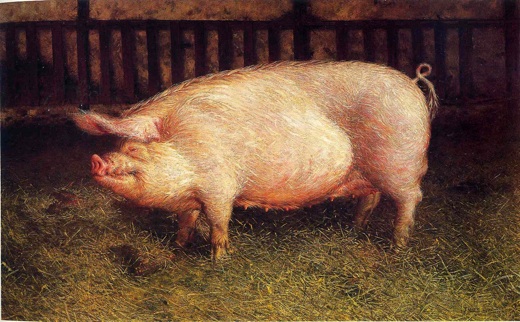
One of the biggest, fattest hogs in the pen would be herded out under a convenient sturdy tree where it was ceremoniously killed. Some used a .22 rifle shot to the head, some a blow to the head with an ax, and some simply slit the animal’s throat.
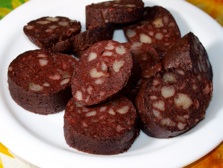
Regardless of the manner of dispatch, many families collected the hog’s blood as it was drained from the body to make that prized delicacy (for some) blut wurst or blood sausage.
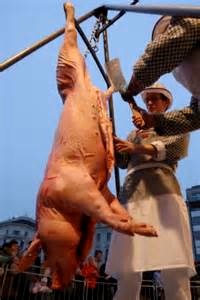
While the killing and bleeding was going on, someone was tending a fire to bring water to a rolling boil in a large, cast iron wash pot. As soon as the dead hog’s hind legs were attached to a singletree or spread on a similar device and hoisted to a tree limb with a block and tackle, the body was scalded with the hot water.
Not only did the water wash off the accumulated pig pen grime, but it softened the hog’s bristle for easier scraping off with either a knife or special scraper.
When the carcass was reasonably clean, there were no high-priced government inspectors or Marvin Zindler looking over our shoulders way back then; the hog’s innards were removed and turned over to the women for cleaning.
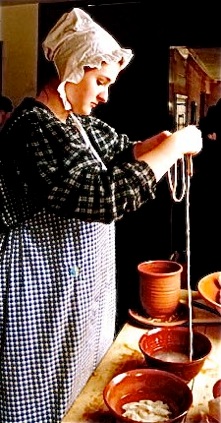
Those yards of intestines had to be washed and rewashed and rewashed again with the insides washed out by dipping some water into one end of the intestine and then pulling the intestine between a finger and blunt edge of a knife.
After all, those intestines would one day go back into a human intestine as casing for smoked or dried pure pork sausage, so they had to be reasonably clean.
As the women were doing their thing, the men were turning the carcass into all kinds of goodies. The copious fat was trimmed and cut into chinks for cooking or rendering into lard, the hams and back meat were cut into convenient sizes and seasoned for ham and bacon and the trimmings cut into small enough pieces to be run through a hand-cranked grinder for the sausage stuffings.
The work was suspended for a while at midday for a hearty lunch, or dinner as it was called around here in those days, prepared by the women who were not outside on the cleaning detail.
After the noon break, it was back to processing the meat to be kept without refrigeration for most of a year.
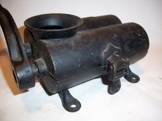
The ground sausage was stuffed into those spotlessly clean intestines with a hand cranked stuffer, tied into links and, along with seasoned hams and bacons hung on sticks supported by the rafters on the family smokehouse.
There a small smoky fire would be kept burning on the dirt floor for weeks to slowly – real slowly – cook the pork.
Then some of the ham and bacon could grow a good beard of mold until it was eaten in the spring and summer. Most of the mold was generally trimmed off before the meat was eaten as smoked meat or as fried specialties with eggs, corn bread and sorghum molasses.
One of my aunts would make a real specialty. She would fry pieces of the fresh pork sausage and preserve them in sealed quart jars of fresh lard. That was some scrumptious sandwich meat.
Pulling a piece of that sausage out of the jar, wiping off most of the lard, slicing it onto a piece of her homemade bread still warm from the oven, and covering it with her homemade ketchup made a sandwich fit for a king.
Today, hygienists, nutritionists, dietitians, cardiologists and all kinds of health nuts would be turning out tons of books telling us that we could not, cannot, and would not live on a diet of all that fat, particularly if it was eaten on an almost daily basis.
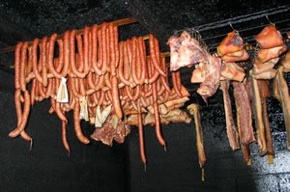
Having it processed under the trees and then preserving it in old smokehouses with dirt, bugs and rodents could only make one of the family’s main meals more deadly.
But just read the local obituaries. Many of those dying today in their 80’s and 90’s grew into adulthood on diets like these.
Could it be that those who survived all the fat and cholesterol worked, and worked hard, "From Can See to Can’t, " or from sun up to sundown, on an almost daily basis?
By contrast, I had the privilege of participating in a family hog killing in Germany 40 years ago. It was considerably different from the ritual practiced by my German family and described above.
First of all, the whole procedure was done in the apartment house courtyard of our daughter’s German godparents in the middle of Rohrbach, an old residential suburb of Heidelberg that’s just across the street from the U.S. Army, Europe, Headquarters.
The pig or hog was much smaller than the fatted hogs used locally and women played no part in the butchering and processing.
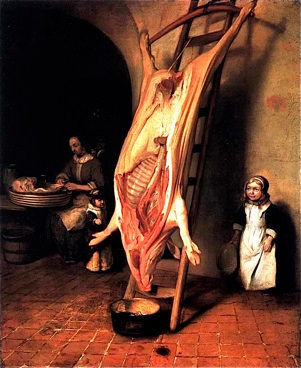
After the wash pot was emptied of the boiling water for cleaning and scraping the pig, the pot was filled with water again and kept boiling for a soup that was to be the men’s lunch.
The lungs and other innards that were not to be used for sausage, noodles, potatoes and other ingredients that it was probably best that I did not see, went into the broth.
Whatever the contents, that boiling pot sure did produce some tasty soup for lunch, particularly with some good fresh black bread.
The Germans also made a lot more different types of sausage from their kill. One was magwurst, or stomach sausage. The pig’s stomach was cleaned in the same way as the intestines, stuffed with a combination of beef and pork cut into small strips and then cured in the same way as the other sausages.
The meat and sausages were not smoked, but seasoned and cured in a darkened bedroom with open windows on the third floor. The street cars and autos rumbling on the street below kept a good coating of dust in circulation so as to add that very special touch.
Then at night, the ladies joined the men for a big fresh pork feast. In addition to a variety of pork dishes, there was the inevitable sauerkraut, potatoes, noodles, bread and butter and real beer and wine.
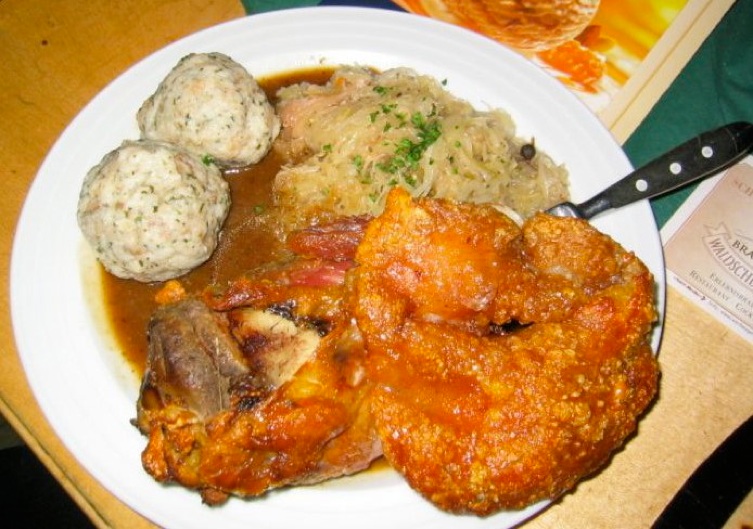
These were just a few of the artery clogging eats still on the table in the "Old Country."
enough





